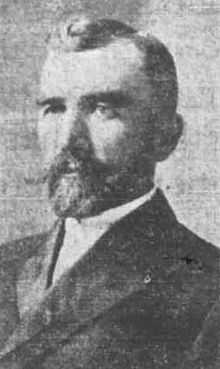Malcolm McKenzie
| Malcolm McKenzie | |
|---|---|
 | |
| Alberta Provincial Treasurer | |
| In office May 4, 1912 – March 15, 1913 | |
| Preceded by | Arthur Sifton |
| Succeeded by | Arthur Sifton |
| Member of the Legislative Assembly of Alberta | |
| In office March 22, 1909 – March 15, 1913 | |
| Preceded by | New district |
| Succeeded by | William Moffat |
| Constituency | Claresholm |
| In office November 9, 1905 – March 22, 1909 | |
| Preceded by | New district |
| Succeeded by | Colin Genge |
| Constituency | Macleod |
| Personal details | |
| Born | May 31, 1863 Kincardine, Ontario |
| Died | March 15, 1913 (aged 49) Edmonton, Alberta |
| Political party | Liberal |
| Children | One son, Malcolm |
| Residence | Fort Macleod, Alberta |
| Alma mater | Queen's University |
| Occupation | Lawyer |
Malcolm McKenzie (May 31, 1863 – March 15, 1913) was a Canadian politician who served as a member of the Legislative Assembly of Alberta and, briefly, as Alberta Provincial Treasurer.
Early life
Malcolm McKenzie was born in Kincardine, Ontario, in 1863. He attended Queens University, from which he graduated with a gold medal in philosophy, and then studied for a year in Toronto. He came west around 1888 and, after a brief stay in Calgary, settled in Macleod, where he joined the law firm Haultain, McKenzie and McNeill. That firm dissolved when its senior partner, Frederick W. A. G. Haultain, went to Regina to serve as the first Premier of the Northwest Territories.[1] McKenzie established another law firm with John McDonald and another lawyer; that firm was called McDonald, Martin and McKenzie.[2]
Political career
McKenzie first sought office in the 1904 federal election, when he ran as the Liberal candidate in Alberta (Provisional District). He was narrowly defeated by John Herron of the rival Liberal-Conservative Party.[3] McKenzie then ran in the 1905 Alberta election, the province's first, as the Liberal candidate in Macleod, where he handily defeated his two opponents.[4] In the first legislature he, along with most members from the province's south, favoured Calgary over Edmonton as the Alberta's permanent capital; his side was out-voted 16 to 8.[5] He also proposed the successful name for Granum, located in his district and hitherto known as Leavings Switch; the area around Granum was known as excellent grain land, and "granum" is Latin for grain.[6]
In the 1909 election, McKenzie was re-elected in the new district of Claresholm, by a margin still larger than the one he had achieved in 1905.[7] During the Alberta and Great Waterways Railway scandal, he remained loyal to the Liberal government of Alexander Cameron Rutherford; when that government fell, he transferred his allegiance to the new Liberal government of Arthur Sifton, though several other former Rutherford partisans (including Rutherford himself) opposed the new regime.[8] His loyalty was rewarded in May 1912 when Sifton appointed him Provincial Treasurer.[9] In keeping with the era's custom, McKenzie responded to the cabinet appointment by resigning his seat in the legislature to contest it in a by-election. Despite his previous wide margins, in 1912 he carried Claresholm by only 14 votes.[10][11]
McKenzie's tenure as treasurer was not to last long: he caught a chill while attending the convention that nominated him as the Liberals' Claresholm candidate in the 1913 election, and by the time he returned to Edmonton on March 10, 1913, he was sufficiently ill to confine himself to bed. He had developed peritonitis, and died from it early in the morning of March 15. The Liberal Edmonton Bulletin, in mourning his passing, said that "no lawyer in the province had such a firm grasp in legal matters. No member of the house performed his legislative duties so admirably and so well. He has left his impression on more legislation than any other member."[1] He was survived by a wife and one son.[1]
Electoral record
| 1912 by-election results (Claresholm)[11] | Turnout N.A. | |||
| Liberal | Malcolm McKenzie | 651 | 50.54% | |
| Conservative | D. S. MacMillan | 637 | 49.46% | |
| 1909 Alberta general election results (Claresholm)[7] | Turnout N.A. | |||
| Liberal | Malcolm McKenzie | 696 | 61.87% | |
| Conservative | J. F. Garrow | 429 | 38.13% | |
| 1905 Alberta general election results (Macleod)[4] | Turnout N.A. | |||
| Liberal | Malcolm McKenzie | 584 | 58.11% | |
| Conservative | David J. Crier | 368 | 36.62% | |
| Independent | Duncan J. D. K. Campbell | 53 | 5.27% | |
| 1904 Canadian general election results (Alberta (Provisional District))[3] | Turnout N.A. | |||
| Liberal-Conservative | John Herron | 1,755 | 51.14% | |
| Liberal | Malcolm McKenzie | 1,677 | 48.86% | |
References
- Thomas, Lewis Gwynne (1959). The Liberal Party in Alberta. Toronto, Ontario: University of Toronto Press.
Notes
- ↑ 1.0 1.1 1.2 "Death Calls Provincial Treasurer". Edmonton Bulletin. March 15, 1913. pp. 1–2. Retrieved 2010-03-31.
- ↑ "The New Liberal Leader". XXIII (The Lethbridge Herald). March 28, 1930. p. 1.
- ↑ 3.0 3.1 "Election results for Alberta (Provisional District), 1904". Parliament of Canada. Retrieved 2010-03-24.
- ↑ 4.0 4.1 "Election results for Macleod, 1905". Alberta Online Encyclopedia. Retrieved 2010-03-24.
- ↑ Thomas 38
- ↑ "Granum". Friends of Geographical Names of Alberta. Retrieved 2010-03-31.
- ↑ 7.0 7.1 "Election results for Claresholm, 1909". Alberta Online Encyclopedia. Retrieved 2010-03-24.
- ↑ Thomas 113
- ↑ Thomas 125
- ↑ Thomas 127
- ↑ 11.0 11.1 "Past By-Election results". Elections Alberta. Retrieved 2010-03-24.